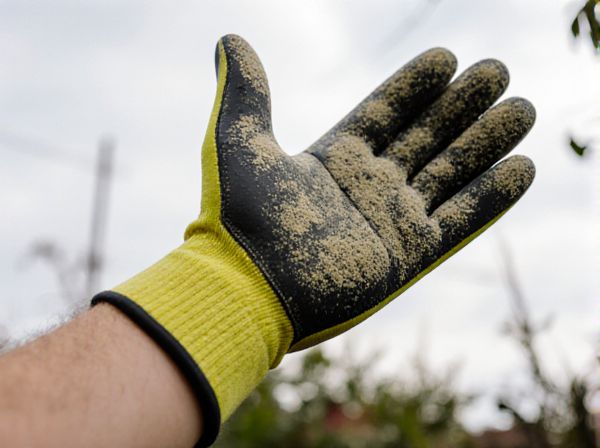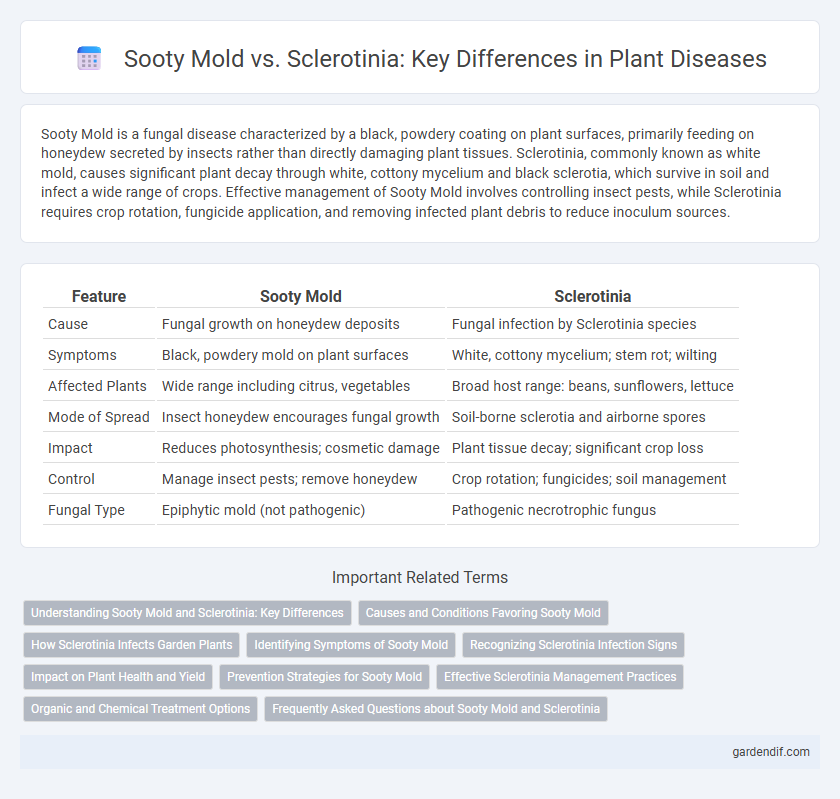
Sooty Mold vs Sclerotinia Illustration
Sooty Mold is a fungal disease characterized by a black, powdery coating on plant surfaces, primarily feeding on honeydew secreted by insects rather than directly damaging plant tissues. Sclerotinia, commonly known as white mold, causes significant plant decay through white, cottony mycelium and black sclerotia, which survive in soil and infect a wide range of crops. Effective management of Sooty Mold involves controlling insect pests, while Sclerotinia requires crop rotation, fungicide application, and removing infected plant debris to reduce inoculum sources.
Table of Comparison
| Feature | Sooty Mold | Sclerotinia |
|---|---|---|
| Cause | Fungal growth on honeydew deposits | Fungal infection by Sclerotinia species |
| Symptoms | Black, powdery mold on plant surfaces | White, cottony mycelium; stem rot; wilting |
| Affected Plants | Wide range including citrus, vegetables | Broad host range: beans, sunflowers, lettuce |
| Mode of Spread | Insect honeydew encourages fungal growth | Soil-borne sclerotia and airborne spores |
| Impact | Reduces photosynthesis; cosmetic damage | Plant tissue decay; significant crop loss |
| Control | Manage insect pests; remove honeydew | Crop rotation; fungicides; soil management |
| Fungal Type | Epiphytic mold (not pathogenic) | Pathogenic necrotrophic fungus |
Understanding Sooty Mold and Sclerotinia: Key Differences
Sooty mold is a superficial fungal growth that thrives on honeydew secreted by insects, primarily affecting the leaves and stems by blocking sunlight and reducing photosynthesis without directly infecting plant tissues. Sclerotinia, caused by Sclerotinia sclerotiorum, is a pathogenic fungus that invades plant tissues, causing white mold disease characterized by water-soaked lesions, wilting, and decay in various crops. Understanding these differences is critical for effective disease management, as sooty mold control focuses on managing insect populations, whereas Sclerotinia requires fungicidal treatments and cultural practices to limit fungal spread.
Causes and Conditions Favoring Sooty Mold
Sooty mold develops primarily from fungal growth on honeydew secreted by sap-sucking insects such as aphids and scale insects, thriving in warm, humid environments that favor insect populations and fungal proliferation. This black, powdery fungal layer impedes photosynthesis by covering leaf surfaces, commonly occurring in gardens and orchards with dense foliage and poor air circulation. Unlike Sclerotinia, which is caused by soilborne pathogens affecting plant tissues directly, sooty mold's presence depends on insect activity and environmental moisture rather than direct fungal infection of plant cells.
How Sclerotinia Infects Garden Plants
Sclerotinia infects garden plants by producing fungal spores that land on plant surfaces and germinate under moist conditions, penetrating tissue through natural openings or wounds. The fungus then invades the plant's vascular system, causing white mold symptoms characterized by cottony mycelium and soft rot. Sclerotinia species, such as Sclerotinia sclerotiorum, survive in soil as hardened sclerotia, enabling long-term persistence and repeated infections in susceptible crops.
Identifying Symptoms of Sooty Mold
Sooty mold presents as a black, powdery coating on the surfaces of leaves, stems, and fruits, often resulting from the presence of honeydew excreted by sap-sucking insects such as aphids, whiteflies, or scale insects. Unlike Sclerotinia, which causes water-soaked lesions, wilting, and white, cottony mycelial growth on infected plants, sooty mold does not directly damage plant tissues but can inhibit photosynthesis by blocking sunlight. Identifying symptoms include the distinctive black fungal growth primarily on the upper leaf surfaces, usually where insect activity is evident.
Recognizing Sclerotinia Infection Signs
Sclerotinia infection is characterized by white, cottony mycelium growth on plant tissues, often leading to soft, water-soaked lesions that turn brown and dry into brittle sclerotia. Unlike sooty mold, which appears as a superficial black coating caused by fungal spores feeding on honeydew, Sclerotinia penetrates plant tissue, causing stem rot and wilting. Early detection of Sclerotinia involves identifying these distinct signs, such as the presence of sclerotia and decayed plant parts beneath the white fungal growth.
Impact on Plant Health and Yield
Sooty mold primarily affects plant health by covering leaves with a black fungal growth that reduces photosynthesis, leading to weakened plants and decreased crop yield. In contrast, Sclerotinia causes more severe damage by infecting plant tissues, resulting in blackened stems, rotted roots, and wilting, often causing significant yield losses or total crop failure. Both diseases compromise plant vitality, but Sclerotinia poses a more direct and destructive threat to overall yield and economic value.
Prevention Strategies for Sooty Mold
Effective prevention strategies for sooty mold involve maintaining plant health through regular pruning to improve air circulation and reduce insect populations like aphids and whiteflies that excrete honeydew, which fosters mold growth. Applying insecticidal soaps or neem oil can control the sap-sucking insects responsible for honeydew production, minimizing the substrate for sooty mold development. Ensuring proper fertilization and watering practices also strengthen plants' resistance against infestations, helping prevent sooty mold proliferation.
Effective Sclerotinia Management Practices
Effective Sclerotinia management practices include crop rotation with non-host plants, timely application of fungicides such as boscalid or fludioxonil, and improving field drainage to reduce soil moisture. Proper removal of infected plant debris and maintaining plant spacing can minimize conducive conditions for sclerotinia sclerotiorum infection. Monitoring environmental conditions, especially prolonged leaf wetness and moderate temperatures, helps optimize treatment timing and reduce disease incidence.
Organic and Chemical Treatment Options
Sooty mold, caused by fungal growth on plant surfaces, can be managed organically using neem oil, insecticidal soaps, and promoting beneficial insects to reduce honeydew-producing pests. Chemical treatments for sooty mold include fungicides with active ingredients such as chlorothalonil or myclobutanil to control fungal spread. In contrast, Sclerotinia, a soil-borne pathogen causing white mold, responds well to organic treatments like crop rotation, biofungicides containing Coniothyrium minitans, and maintaining proper irrigation; chemical control often involves fungicides with boscalid, fludioxonil, or iprodione to reduce sclerotia formation and infection rates.
Frequently Asked Questions about Sooty Mold and Sclerotinia
Sooty Mold is a black fungal growth that develops on plant surfaces, feeding on honeydew excreted by insects like aphids and whiteflies, whereas Sclerotinia, known as white mold, is a pathogenic fungus causing wilting and rot in many crops. Frequently asked questions often address differences in appearance, transmission, and control methods--Sooty Mold primarily affects aesthetics and is controlled by managing insect populations, while Sclerotinia requires fungicide application and crop rotation due to its aggressive infection of plant tissues. Understanding these distinctions is crucial for effective disease management in agriculture and horticulture.
Sooty Mold vs Sclerotinia Infographic

 gardendif.com
gardendif.com